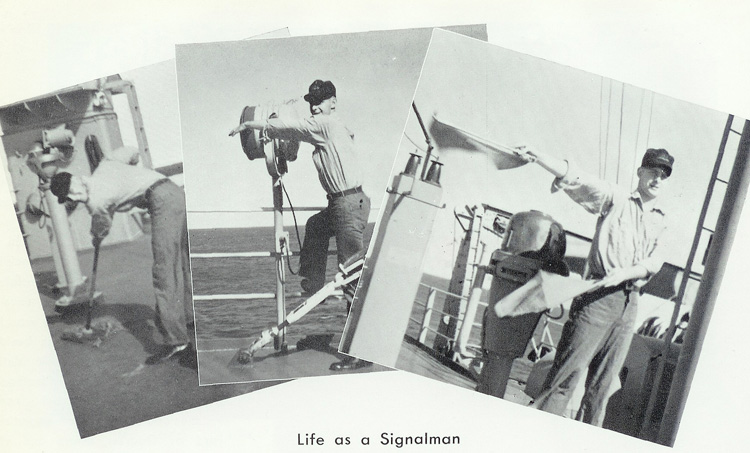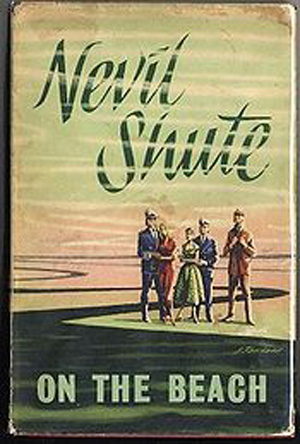3. Classified Material
My first assignment upon reporting aboard the PICTOR was Assistant Navigator, and this was more or less at my request because the subject interested me, and they didn’t have anywhere else to place me on short notice. Later, however, a new officer came aboard who was a direct transfer from the California Maritime Academy. He knew navigation, but was not really up to speed on things “Navy.” As a result, I was made Communications Officer and he became Navigator. There was no way I could avoid it, I had, after all, been formally trained for that position.
Being Communications Officer meant supervision of radiomen and signalmen. These were a good group of guys, smart and motivated, so not much supervision was required on my part.
It also meant being in charge of encryption and decryption of classified communications, and that consumed the bulk of my time. Classified communications usually arrive designated either CONFIDENTIAL, SECRET, or TOP SECRET. Being as we were an auxiliary vessel and not a combat vessel there was hardly ever anything classified above SECRET. In addition, each message was also assigned a precedence dictating how quickly a message had to be processed. These were ROUTINE, PRIORITY and FLASH. Sometimes it was difficult to understand why certain communications were categorized as they were. For instance, if a message came in while I was in my bunk sound asleep, which was designated SECRET and PRIORITY it meant a radioman had to roust me out of my sleep to go and decrypt the message without delay. We actually received very few messages with this type of designation, but one that always came that way was the monthly WESTPAC Venereal Disease (VD) Report. This report ranked each of the usual Navy ports of call in the Western Pacific by the number of cases of VD per one thousand liberties. What was so SECRET about that? Why the PRIORITY precedence? After a while I would, upon discovering the nature of the report, shut down the decryption machine, go back to my bunk and finish the process at a decent hour in the morning.
After I had been Communications Officer for a period time, the Executive Officer called me into his office to tell me I was being assigned the collateral duty of Classified Material Control Officer. I reminded him that I was only cleared up through SECRET and I knew that we had at least one TOP SECRET document aboard the PICTOR. “No problem,” he informed me. At the Captains discretion they were giving me an interim TOP SECRET clearance which would be specific to this command. He then gave me the combination to the TOP SECRET safe which was located in the crypto room and sent me off to my new responsibility.
Well. . .okay. I went directly to the crypto room, opened the safe and took out a single envelope stamped, in big red letters, TOP SECRET. I remember reading this document and feeling as if I were privileged to some kind of holy of holies. The nature of this document was such that I can tell you its nature without divulging its secret. In fact, I have long ago forgotten the actual secret. Remember, this was circa 1963 and the cold war was in full swing. The secret was simply a longitude and latitude somewhere in the middle of the Pacific Ocean (I never bothered to plot it on a chart). This spot was to be a rendezvous where whatever was left of the U.S. Navy would assemble should WWIII break out, resulting in a full nuclear exchange between the USA and the USSR. It assumed that the only thing left of the Navy might be ships that happened to be at sea at the time of the war. How long would such a war last, an hour maybe, an hour and a half? At any rate this was where where the remainder was to gather, scratch their heads and try to decide what to do next.
One is strongly reminded of the novel by Nevil Shute entitled On the Beach (1957). The story imagines a circumstance as described above.
It was made into a movie with the same name (1959) starring Gregory Peck and Ava Gardener. The phrase “on the beach” is a long-standing naval expression used to describe the location of any crew member who has left the ship and gone ashore. I wonder if the book and movie in any way influenced the document I viewed in 1963.
The radio shack also had a machine that was considered okay for use up through SECRET. As I remember it was called JASON. It involved messages which were scrambled by a random number generator when sent and unscrambled upon receipt. It was the wave of the future, unlike the hand operation in the crypto room which, I think, was called ADONIS. I remember one unique occasion when I was awakened in the middle of the night:
“Mr. Mason! Mr. Mason! We’ve got TOP SECRET coming through in the clear on the JASON system!”
“What? That’s impossible!”
“No! No! it’s true. You had better come and take a look!”
I threw on some clothes and stumbled up to the radio shack. I was greeted by the first class radioman.
” Sir, I cleared everybody out there and sent for you. We’re only cleared for secret.”
I went in, sat down in front of the teletype machine and started reading. Sure enough, the message began TOP SECRET, FLAG OFFICERS ONLY (Commodore or above). Whoa! I certainly wasn’t a flag officer, but I read the message any way. It wasn’t my mistake.
At that time the Vietnam situation was just beginning to heat up, and as I remember, the message was simply an evaluation of the infiltration of North Vietnamese troops into South Vietnam. My reaction at the time was: “This is TOP SERECT? I read this in Time Magazine.”
As I was reading, the machine suddenly came to an abrupt halt! There was a pause, of perhaps a minute, and then it came to life with: DESTROY THIS MESSAGE IMMEDIATELY! or words to that effect. Apparently someone at the communications center had loaded a tape on the the wrong system and the mistake was caught in progress.
These things all happened almost fifty years ago, and I sincerely doubt that they are of any signifigance today. One thing is for sure, WWIII hasn’t happened yet so I am still here and able write Uncle Rob’s Sea Stories.
1 Comment to 3. Classified Material
Leave a comment
Categories
- THE GALLERY
- Uncle Rob's Art
- 3D Works (stills) I
- 3D Works (stills) II
- 3D Works (stills) III
- 3D Works (video)
- Design & Abstract I
- Design & Abstract II
- Design & Abstract III
- Figurative Works I
- Figurative Works II
- Landscapes I
- Landscapes II
- Largest Art Project
- Nautical and Marine Images (video)
- Nautical and Marine Images I
- Nautical and Marine Images II
- Nautical and Marine Images III
- Nautical and Marine Images IV
- Portraits
- Still Life Images
- Stump Hollow Photo Essay I
- Stump Hollow Photo Essay II
- Uncle Rob's Mendocino Shop
- The Five Sense Series
- Irene's Creations
- Works by Don Mason
- Works by Don Mason II
- Works by Joseph de Borde
- Painting by Albert Robbins
- Art by Leslie Masters Villani
- Paintings by Nellie Harriet Parker
- The Art of Bee Yearian
- Works by Evie Wilson
- Uncle Rob's Art
- SCHOONER MOON BOOKS
- SEA STORIES
- ONE DOZEN AND TWO ESSAYS
- Cousinhood
- Art by Definition
- Cake Mixed Economy
- Marriage Anyone?
- Sex and/or Violence
- Searching for Truth
- The Philosophical Roots of Science
- Stepping Stones and Stumbling Blocks
- On Being Good
- Teaching By Example
- The Basic Law of Civilization
- Where Goeth Evil?
- A Modern Empircal "Religion"
- Knowledge as Wealth
- PAPERS AND ARTICLES
- FAMILY STORIES
- BOOK REVIEWS
Archive
- December 2021
- October 2020
- June 2020
- September 2019
- July 2017
- March 2017
- December 2016
- November 2016
- October 2016
- August 2016
- July 2016
- June 2016
- May 2016
- March 2016
- February 2016
- February 2015
- January 2015
- February 2014
- December 2013
- November 2013
- August 2013
- June 2013
- August 2012
- July 2012
- April 2012
- March 2012
- February 2012
- November 2011
- September 2011
- June 2011
- May 2011
- April 2011
- March 2011
- February 2011
- January 2011
- December 2010
- November 2010
- October 2010
- September 2010
- August 2010
- July 2010
- June 2010
- May 2010
- April 2010
- March 2010
- February 2010
- January 2010
- December 2009
- November 2009
- October 2009
- September 2009
- August 2009
- July 2009
- June 2009
- May 2009
- April 2009
- March 2009
- February 2009
- January 2009
- December 2008
- November 2008
- October 2008
- September 2008


Very impressive Blog page. You certainly have had a
varied and interesting life and you are an excellent
writer. Although our naval experience was very different,
I am glad we both got to enjoy Sasebo.